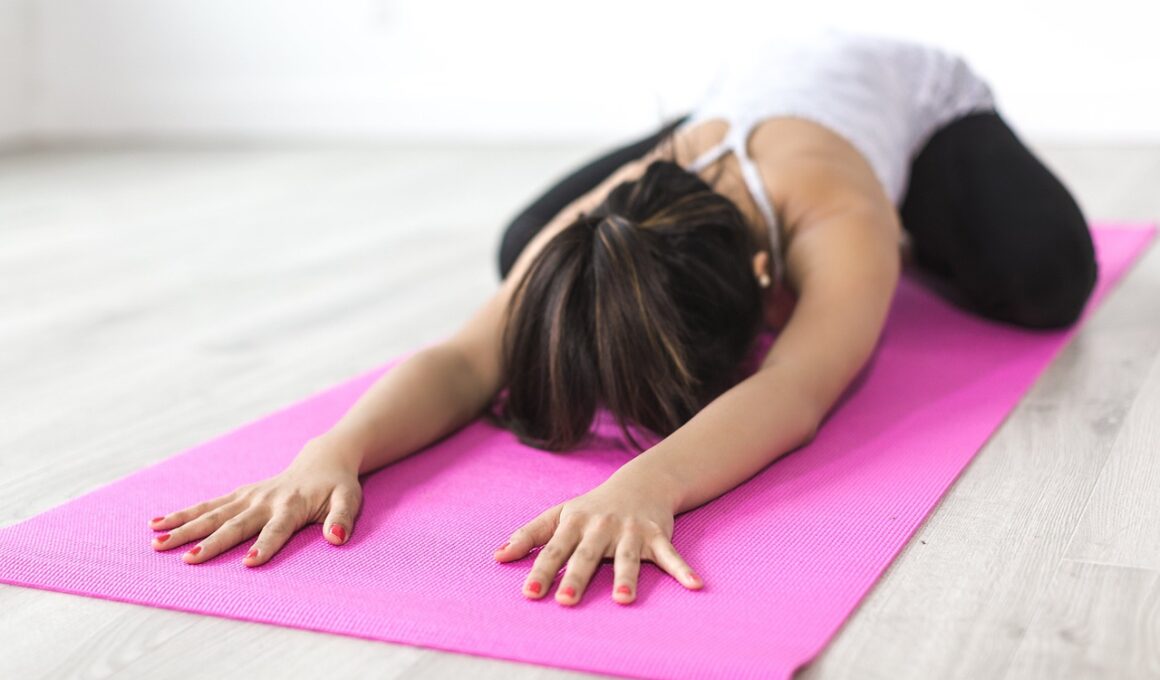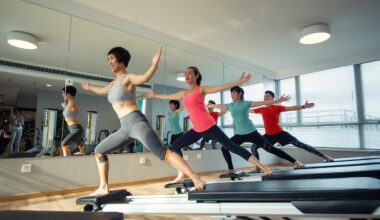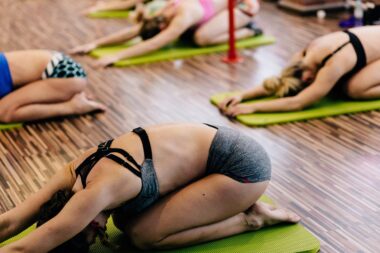Flexibility and Functional Fitness: Tips for Beginners Starting Out
Getting started with flexibility exercises can be an exciting journey towards improving overall functional fitness. As beginners, focusing on flexibility helps enhance muscle coordination and reduce injury risks. Effective flexibility exercises contribute to better performance in various fitness activities, encouraging movement quality in daily life. To kick off your routine, allocate time for proper warm-up to prepare your muscles. This can be accomplished through dynamic stretches that involve gradual movement. Gradually introducing static stretches afterward promotes muscle elongation. To achieve optimal results, aim to stretch at least two to three times a week. Hold each stretch for around 20-30 seconds without bouncing to ensure safety and effectiveness. Explore different techniques, ranging from yoga to Pilates, for enhancing your flexibility skills. Incorporate variety within your routine for sustained motivation and improvement. Tracking your progress is essential; consider maintaining a journal to record your stretching achievements and challenges. Ultimately, listen to your body and respect its limits, ensuring gradual growth in capabilities.
Incorporating flexibility exercises into a comprehensive functional fitness program is vital for a balanced workout. Flexibility is critical for proper movement patterns, promoting better performance in sports and activities. Gradual implementation of various stretches will help assist in achieving greater flexibility over time. Begin each session with specific goals in mind, ensuring focus on different muscle groups. Include stretches that target major areas such as hamstrings, quadriceps, shoulders, and back for a comprehensive approach. Utilizing tools like foam rollers, resistance bands, or yoga blocks can enhance your flexibility routines. When performing these exercises, ensure you engage your mind to promote proper technique, emphasizing control and form. It is beneficial to partner with a coach or an experienced partner. They can provide guidance on executing stretches correctly. Join a group class or workshop to gain additional insights from experienced instructors. Remember, a supportive community makes the journey enjoyable and less daunting. By consistently dedicating time to your flexibility practice, you will witness improvement over weeks and months, enhancing both your functional fitness and overall quality of life.
The Importance of Stretching
Understanding the significance of stretching is vital for anyone beginning their journey in functional fitness. Stretching serves multiple purposes – increasing blood flow, enhancing flexibility, and reducing soreness post-exercise. These benefits contribute significantly to overall muscle performance and recovery. Without adequate flexibility, reaching peak performance can become challenging. This can lead to muscle tightness, poor posture, and decreased range of motion in your daily movements. Emphasizing flexibility within your fitness regime helps combat these issues effectively. Engaging in regular stretching activities increases joint mobility and supports overall muscle function. Security in movement can elevate confidence when participating in various exercises, making them more enjoyable. Participating in group classes or guided sessions often helps beginners remain motivated. Additionally, building strength through flexibility aids in improving muscle balance and coordination. Consistently incorporating stretching exercises into your fitness regime builds resilience over time. Whether it’s after a workout or as part of a warm-up, recognizing these moments allows for profound physical benefits that resonate beyond your workouts.
Another vital aspect of flexibility in functional fitness is awareness of how body mechanics function together. Understanding range of motion is crucial for maximizing stretching effectiveness. By developing this awareness, individuals can enhance their ability to perform dynamic movements correctly. When experiencing tightness or discomfort during exercises, it poses limitations. This would restrict participation in various activities. Therefore, focusing on flexibility becomes paramount in overcoming these difficulties. Beginner athletes should be mindful of their individual assessments before starting any exercise. Identifying areas of tension can help tailor a program specifically to individual needs. Utilizing online resources or consulting fitness professionals can provide personalized assessments. Additionally, maintaining proper hydration and nutrition is essential for muscle recovery and flexibility. Fuelling your body with the right nutrients helps promote healthy muscle function while supporting overall flexibility improvements. Allow your body time to rest and recover, integrating rest days into your routine, ensuring muscles are not overextended or exhausted, leading to enhanced stretching outcomes. This approach also motivates effective flexibility gains, setting the stage for future success.
Best Flexibility Exercises for Beginners
To strengthen your fitness journey, begin by incorporating basic flexibility exercises designed for beginners. One effective exercise is the standing quadriceps stretch. For this stretch, stand on one leg and bring the other foot toward your glutes, ensuring a straight posture. Focus on maintaining balance and gently pulling your foot for an improved stretch. Another beginner-friendly stretch is the seated hamstring stretch. Sit with one leg extended and gently reach toward your toes, utilizing a relaxed and controlled motion. Gradually extend your reach as comfort increases. The cat-cow stretch, done on all fours, is excellent for spinal mobility. Alternating between arching and rounding your back promotes flexibility and alleviates tension. Dynamic stretches like leg swings and arm circles can also maximize your flexibility routine. Incorporating these stretches into your warm-up prepares your muscles for activity, minimizing injury risk. Finally, remember to cool down with static stretches for muscle relaxation. Establish a consistent routine that incorporates these fundamental flexibility exercises to ensure effective outcomes over time, setting you on the path to progress.
As you advance in your flexibility journey, consider integrating additional tools to enhance your routine. Stretching straps or resistance bands are excellent resources for deepening stretches and improving range of motion. They allow for a greater stretch by providing additional leverage and assistance when working on tight areas. Another beneficial tool includes a stability ball, offering unique stretching variations and support for specific exercises. Remember to remain mindful of proper form and posture while using these tools. Additionally, searching for informative videos or tutorials online can provide guidance on exercise execution. Connecting with a fitness community—whether online or locally—supports ongoing motivation and accountability. Share experiences and seek advice from others on achieving better results. Once you become comfortable with a variety of stretches, consider progressing to advanced variations that challenge your flexibility limits. Public classes or workshops can offer new techniques or styles to try, keeping your routine fresh and engaging. Ultimately, consistency, patience, and gradual progression foster a fulfilling journey towards unparalleled functional fitness and significant improvements in flexibility.
Conclusion: Staying Committed to Flexibility
Staying committed to flexibility as part of your functional fitness encourages personal growth and resilience. Regardless of your starting point, everyone can experience positive changes in their flexibility. Building this commitment entails creating a structured plan based on individual goals while ensuring consistency. Prioritize flexibility sessions equally alongside strength endeavors within your overall fitness program. As you continue to stretch and improve, recognize that the journey has personal significance. Celebrate your victories, even the smallest achievements, as they contribute to long-term success. Embrace the challenges that arise, viewing setbacks as opportunities for learning and growth. Over time, you will witness improvement not only in flexibility but also in core skills such as balance and stability. Remember that maintaining a positive mindset can fortify your perseverance, helping you push through difficult moments. Whenever motivation wanes, remind yourself of the physical and mental benefits flexibility imbues into your functional fitness journey. Seek support from friends or fellow fitness enthusiasts. By doing so, you enrich your experience while continuing to prioritize flexibility as a significant component of your lifestyle.
Lastly, consider tracking your flexibility milestones as a more tangible method to maintain motivation. Use a fitness journal or mobile app to record progress over time. Documenting your experiences fosters accountability and helps identify areas needing improvement. Consistently checking in on your goals reaffirms your dedication to your flexibility journey. Establishing a reachable framework assists in reducing aspirations into manageable pieces. As you observe gradual improvements, you will likely find increased confidence in pursuing new fitness activities. Such a transformation can lead to exciting opportunities within functional fitness, where flexibility plays a crucial role. Acknowledge daily improvements, no matter how small, and celebrate your achievements with friends or personal milestones. This practice encourages a supportive environment that motivates you to continue stretching and remaining dedicated to improvement. Flexibility exercises ultimately serve as a foundational element in achieving your overall fitness aspirations. Make sure to keep refining your routine, seeking better alignment and quality movements over time. By actively committing to ongoing enhancement, you’ll support not only your physical well-being but also your mental resilience and confidence.





